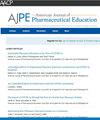评估一个三管齐下的自我评估工具,以提高一年级药学学生的沟通技巧:一项多机构研究。
IF 3.8
4区 教育学
Q1 EDUCATION, SCIENTIFIC DISCIPLINES
引用次数: 0
摘要
目的:评估一种新颖的三管齐下的自我评估工具对两所药学院药学一年级学生语言和非语言沟通能力的影响。方法:本研究于2022-2023学年进行,涉及来自两所院校的200名药学一年级学生。学生们录下了一个病人咨询的过程,并利用三管齐下的工具在三个不同的阶段对他们的表现进行自我评估:(1)评估非语言交流的纯视频复习,(2)评估语言交流的纯音频复习,(3)综合评估的音频和视频结合复习。然后,学生们录制了第二次分级咨询。采用描述性统计和Wilcoxon符号秩检验分析了首次和随后咨询期间学生成绩的变化;从自我评估反馈的定性数据被分类为主题,以探索共同的沟通优势和改进的领域。结果:队列1(虚拟)的得分从76.9%提高到88.9%,队列2(面对面)的得分从94.3%提高到95.7%。队列3(虚拟)无明显改善。学生们确定了在非语言和语言沟通技巧方面的优势和需要改进的地方,展示了自我评估和技能提升的参与。结论:观察到药学一年级学生沟通能力的提高可能受到三管齐下的自我评估工具、标准教师反馈和研究设计的其他方面的影响。该工具促进了结构化的自我评估和持续改进,与教育标准保持一致,并提出了更广泛应用的潜力,有待于在不同的教育环境中进一步验证。本文章由计算机程序翻译,如有差异,请以英文原文为准。
Evaluating a Three-Pronged Self-Assessment Tool to Enhance Communication Skills in First-Year Pharmacy Students: A Multi-Institutional Study
Objective
To evaluate the impact of a novel, three-pronged self-assessment tool on the verbal and nonverbal communication skills of first-year pharmacy (P1) students at two Schools of Pharmacy.
Methods
This study, conducted during the 2022–2023 academic year, involved 200 P1 students from two institutions. Students recorded a patient counseling session and utilized the three-pronged tool to self-assess their performance in 3 distinct phases: (1) video-only review for evaluating nonverbal communication, (2) audio-only review for assessing verbal communication, and (3) a combined audio and video review for a comprehensive assessment. Students then recorded a second graded counseling session. Changes in student grades between the initial and subsequent counseling sessions were analyzed using descriptive statistics and Wilcoxon signed-rank tests. Qualitative data from self-assessment responses were categorized into themes to explore common communication strengths and areas for improvement.
Results
Cohort 1 (virtual) showed a significant improvement in scores from 76.9% to 88.9%, while Cohort 2 (in person) improved from 94.3% to 95.7%. Cohort 3 (virtual) showed no significant improvement. Students identified strengths and areas for improvement in both nonverbal and verbal communication skills, demonstrating engagement in self-assessment and skill enhancement.
Conclusion
Improved communication skills observed in P1 students were likely influenced by the 3-pronged, self-assessment tool in conjunction with standard faculty feedback and other aspects of the study design. This tool promotes structured self-assessment and continuous improvement, aligning with educational standards and suggesting potential for broader application, pending further validation across diverse educational settings.
求助全文
通过发布文献求助,成功后即可免费获取论文全文。
去求助
来源期刊
CiteScore
4.30
自引率
15.20%
发文量
114
期刊介绍:
The Journal accepts unsolicited manuscripts that have not been published and are not under consideration for publication elsewhere. The Journal only considers material related to pharmaceutical education for publication. Authors must prepare manuscripts to conform to the Journal style (Author Instructions). All manuscripts are subject to peer review and approval by the editor prior to acceptance for publication. Reviewers are assigned by the editor with the advice of the editorial board as needed. Manuscripts are submitted and processed online (Submit a Manuscript) using Editorial Manager, an online manuscript tracking system that facilitates communication between the editorial office, editor, associate editors, reviewers, and authors.
After a manuscript is accepted, it is scheduled for publication in an upcoming issue of the Journal. All manuscripts are formatted and copyedited, and returned to the author for review and approval of the changes. Approximately 2 weeks prior to publication, the author receives an electronic proof of the article for final review and approval. Authors are not assessed page charges for publication.

 求助内容:
求助内容: 应助结果提醒方式:
应助结果提醒方式:


